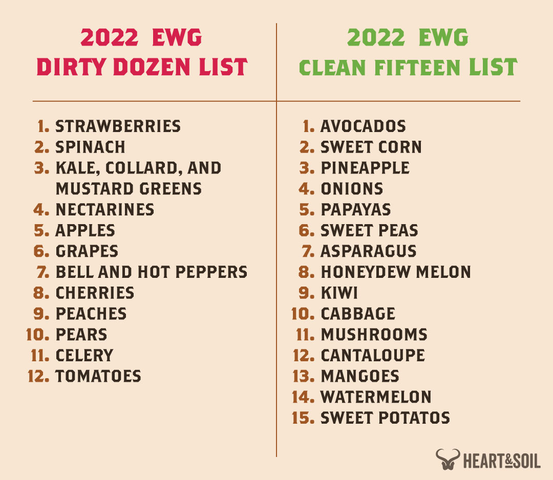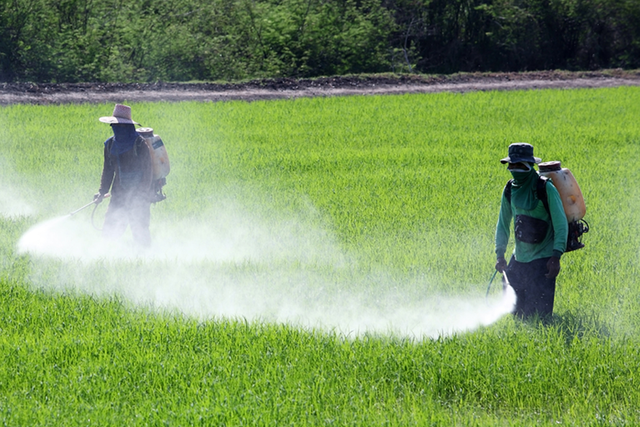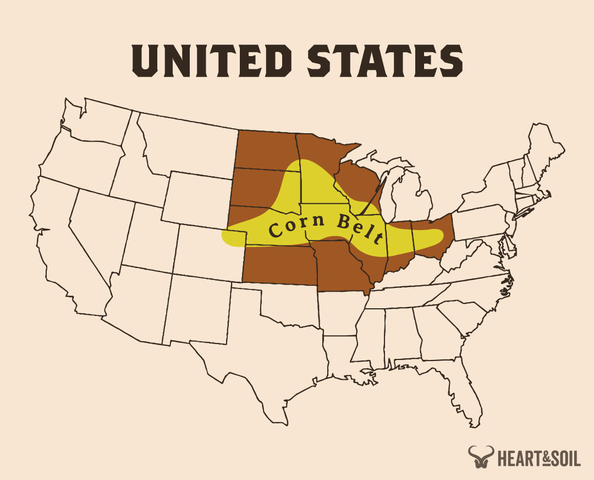- Produce and Pesticide Usage
- Glyphosate: The Good, The Bad, and The Ugly
- The Facts About the USDA Organic Certification
- Farming Methods of Organic and Conventional Foods
- Nutritional Differences Between Organic and Conventional Foods
- Environmental Impacts of Pesticides
- 7 Tips to Avoid Harmful Pesticides
Over the years, most of us have realized the differences between organic and conventional foods. We know that organic foods are generally more nutritious and contain less pesticides than conventional foods. At the same time, you may have heard that the Organic Certification is just a “marketing ploy” used by big agricultural companies. So what’s the truth? Are organic foods really healthier? How much pesticides are found in conventional foods and how harmful are they anyway? What about the nutritional value or environmental impacts of organic and conventional foods?
Today, we’re diving into the details. You’ll learn about the history of pesticides, the truth about the USDA Organic Certification, the nutritional differences between organic and conventional foods, and the impact each has on our environment. Plus, we’ll share 7 tips to help you avoid harmful pesticides and find healthy foods.
Produce and Pesticide Usage
Each year, the Environmental Working Group (EWG) uses data from the USDA and FDA to come up with a “Dirty Dozen” and “Clean Fifteen” list focusing on pesticide exposure for produce.
According to this year’s data, more than 70% of non-organic produce sold within the United States contains pesticide residue. Many of these residues can remain after peeling or washing your fruits and vegetables. Even worse, they found that over 90% of samples for strawberries, apples, cherries, grapes, nectarines, and spinach contained residues from two or more pesticides. A single sample of mustard greens, kale, and collard greens had over twenty different pesticides. However, around 70% of the items from the “Clean Fifteen” list had no identifiable residues.
These lists tell us that some produce is clearly more prone to pesticide usage than others.

It’s not just the United States that uses pesticides heavily. High levels of pesticide usage are prominent in other countries as well.
For example, the European Union approves around 385 pesticides for conventional agricultural use. 340 of these are known to have some level of toxicity. When it comes to organic agriculture, 26 pesticides are approved for agricultural usage, and 10 have some known toxicity (1). One of the most notable options used around the globe is called glyphosate.
Glyphosate: The Good, The Bad, and The Ugly
Glyphosate is a herbicide developed in the 1970s that has become a staple in conventional farming practices and household products such as Roundup. This herbicide is designed to kill plants that aren’t engineered to resist it.

It works primarily by inhibiting the shikimate pathway (2), a metabolic pathway incorporated by bacteria, plants, fungi, algae, and archaea. Additionally, it’s often used as a ripener or desiccant prior to harvest on many common crops such as oats, wheat, barley, and numerous others.
Glyphosate is the most widely used herbicide worldwide, especially in the United States. The US uses roughly 20% of the world’s glyphosate yearly but only accounts for about 4% of the global population. Usage has increased exponentially each year since 1974.
In 2014, an estimated 825,000 tons were sprayed. This number was projected to exceed 1 million tons in the following years (3). In fact, the global market for glyphosate during 2022 is expected to be around $34 billion.
Is Glyphosate Cancerous or Non-Cancerous? It’s Complicated…
Despite its prominence throughout the globe, there is little consensus regarding the safety of glyphosate. The European Food Safety Authority has listed it as a potent human carcinogen, while the USEPA describes it as non-cancerous for humans. In 2015, the International Agency for Research on Cancer (IARC) listed glyphosate as a “probable carcinogen.”
There have been numerous human and animal studies looking at glyphosate exposure and how it potentially relates to a variety of health challenges:
- A systematic review showed that glyphosate exposure was associated with gastrointestinal problems and an increased risk of celiac disease (4).
- In vitro studies of gut cells in humans and mice noted that glyphosate upregulates a protein called zonulin which can contribute to leaky gut (5).
- Glyphosate may contribute to a leaky gut by disrupting digestive enzymes, which can lead to undigested proteins (6).
- A rat study exposed mothers to glyphosate during lactation and pregnancy. The second and third generations of offspring had high levels of rare genetic diseases (7).
- Numerous studies have noted that glyphosate and GBH (glyphosate-based herbicides) products can lead to oxidative stress and damage certain organs (the liver in particular) (8, 9).
- Studies on human and animal cells have shown that consistent exposure to low doses of glyphosate and glyphosate-based herbicides can lead to endocrine disorders (10).
Glyphosate: Lawsuits and Major Cases
Monsanto, who created Roundup (a glyphosate-based herbicide), has been involved in almost 100,000 lawsuits paying out around 11 billion dollars. As of May 2022, there were still an estimated 26,000 active lawsuits. (11)
A major case occurred in California surrounding a groundskeeper who developed Non-Hodgkin’s lymphoma after topical exposure to glyphosate caused by a faulty sprayer. During the trial, it was discovered that Monsanto wrote papers surrounding the purported safety of glyphosate and paid prominent experts to endorse their work. The groundskeeper was awarded 289 million dollars ($252 million for punitive damages). However, it is still scientifically unclear exactly how glyphosate exposure can potentially lead to non-Hodgkin’s lymphoma and other challenges.
Glyphosate and Environmental Concerns
There are also numerous environmental concerns surrounding glyphosate usage. Glyphosate has been detected in drinking water and runoff from storm and sewer drains. This exposure appears to come primarily from agricultural and urban runoff. Studies have shown that glyphosate residues can remain in the soil for up to six months (12) and contaminate surrounding aquatic ecosystems (13).
Additional studies have also been conducted surrounding glyphosate levels in food and water:
- International studies have shown traces of glyphosate in fruit juices, vegetables, cereal, wheat, legumes, animal products, and certain fruits (14).
- A study in Mexico showed levels of glyphosate in almost all samples of drinking water taken. The values were much higher than the legal limit (15).
- A study in the US on 3732 water samples showed that 1470 had levels of glyphosate. One sample had 5000x the legal limit (16).
Glyphosate isn’t just in our food…
Levels of glyphosate have also been detected in numerous consumer products such as tampons, cotton products, cigarettes, and more.
The exact health impact of glyphosate and other herbicides is unclear, but what is clear is that we probably should avoid it. There are steps we can take to reduce our exposure. The best way we can reduce our exposure to glyphosate is through supporting organic agricultural practices.
The Facts About the USDA Organic Certification
The USDA organic certification has become commonplace today, but what does it even mean?

Here are a few points to consider when deciding to buy organic:
- USDA Organic Certified products are required to be grown without synthetic pesticides, GMOs, fertilizers, or herbicides.
- Glyphosate is one of these prohibited herbicides, but organic crops can still be exposed to it through spray drift, runoff, or other methods of exposure.
- Land use for organic production must be free from prohibited substances for at least three years to gain organic certification.
- Preservatives and additives are banned and the aim is to enhance biodiversity within ecosystems.
- Most synthetic substances are banned in organic practices unless no naturally occurring alternatives are available.
Choosing products with this certification can drastically reduce exposure to potentially harmful pesticides and other synthetic inputs. This is a key difference between organic and non-organic products.
Farming Methods of Organic and Conventional Foods
Conventional and organic farming practices differ in several other ways that are important to consider. The goals of conventional production tend to center around productivity and using the smallest amount of inputs (space, feed, etc.). However, while productivity increases, it can lead to the declining health of the animals and the soil.
As noted above, conventional farms have a large dependence on synthetic pesticides for plant protection. Organic operations however, tend to focus on more natural methods, such as crop rotation and the presence of natural enemies. Plus, artificial fertilizers and pesticides are not used in organic food production.
However, a comparative analysis from the EU found that 6.5% of organic samples still contained pesticide residues, whereas over 44% of conventionally grown products contained residues (17). Unapproved pesticides have been noted to contaminate organic products through spray drift from neighboring fields, fraudulent use, contamination from transport, and mislabeling.
Certified organic foods should also be free from genetically modified organisms (GMOs). GMOs are living organisms that have undergone artificial manipulation of their genetic material. Genetic modification leads to unnatural combinations of animals, plants, or bacteria that don’t occur inherently in nature. Many of these modifications are aimed at creating resistance to herbicides such as glyphosate.
So, organic foods can still have some exposure to pesticides, but it tends to be far less than their conventional counterparts. Organic options are also free from genetically modified inputs. These are both good reasons to choose organic.
Nutritional Differences Between Organic and Conventional Foods
How do the nutritional profiles differ between organic and conventional foods?
There doesn’t appear to be a major nutritional difference between conventionally and organically grown fruits and vegetables. (weird, we know, but hear us out…)
Many epidemiological studies have shown potential benefits come from focusing on organic foods. Still, it’s difficult to attribute the benefits solely to going with organically grown foods due to the healthy user bias. For example, it’s been shown that consumers of organic products are more likely to be active and less likely to smoke (18). These factors can make the results more difficult to interpret in certain studies.
That said, there are several key distinctions to consider:
- Organic fruits and vegetables were shown to have lower levels of lead compared to conventional options (19)
- Dried fruits were analyzed for aflatoxin and ochratoxin. Organic options showed a lower likelihood of exposure to mycotoxins (20, 21).
- Studies on pesticide excretion consistently show reduced levels of metabolites with an organic diet (22).
- A meta-analysis of 343 peer-reviewed publications concluded that organic crops tend to have a lower cadmium concentration (23), which is a metal known to be carcinogenic and can accumulate in the kidneys and liver. It has also been shown to demineralize bone.
Research on organic food consumption is somewhat scarce. Long-term interventional studies are needed to better understand the differences between organic and conventional foods.
As of 2020, no long-term clinical trials focused on direct health outcomes of organic diet intervention. The short timeframe (generally a few months) hinders drawing conclusive results. (24).
Environmental Impact of Pesticides and Conventional Food Production
Possibly the greatest benefit of consuming primarily organic foods is the positive environmental impact it can have. In order to better understand the benefits, let’s first talk about the alternative: conventional agriculture and its negative impact.
Conventional agricultural practices “monocropping” which consists of planting the same crop yearly. Monocropping can be incredibly profitable and lead to increased yields, but it comes at a severe cost.
Monocropping depletes the soil of its micronutrients (25), increases the likelihood of runoff, decreases the microbial activity of the soil, and increases the need for synthetic inputs due to the decreased ability to fight pests and diseases. All bad things.
We all know that ecosystems thrive on diversity, yet an estimated 70% of farmland in the US during 2020 was dedicated to corn and soy (both monocropped), according to USDA data. Many of these crops are genetically modified, and some aren’t safe for human consumption. This lack of diversity from monocropping can contribute to various problems, as seen in the US corn belt, which extends from Ohio to Nebraska. The vast majority of corn grown in the US comes from this area, and a recent study pointed out that 35% of the corn belt has lost its topsoil entirely (26). Throughout the midwest, environmental challenges from topsoil loss come with an estimated yearly cost of $3 billion.

Healthy Soil is Crucial for Growing Nutrient Dense Foods
Crops depend on the water and nutrients stored in healthy topsoil, but the soil on conventional farms tends to contain less moisture and offer fewer nutrients.
A recent study took soil samples from 48 states and showed that organic soils were 13% higher in organic matter compared to conventional soils (27). Organic soils were also more likely to store carbon over the long term. Long or short-term carbon sequestration can then improve the soil structure through a reduction in erosion, increased nutrient reserves for plants, and improved water filtration and water holding capacity.
Organic farming practices can significantly reduce the need for pesticides, given the populations of healthy pollinators and enemies which naturally remove pests and weeds.
Other commonly used organic practices include crop rotation, fallowing, and rotational grazing practices, which have been shown to lock carbon in the soil.
While the science on the nutritional profiles between conventional and organically grown crops seem unclear, the differences in environmental impact are worth considering.
7 Tips to Avoid Harmful Pesticides and Find Healthy Foods
Even with the challenges described above, we can still take plenty of steps to avoid pesticides, herbicides and choose products that are in alignment with the health of our environment:
- Buy organic products as much as possible. As we’ve seen, these are far less likely to have exposure to pesticides and herbicides.
- EatWild.com is an excellent resource for finding locally grown organic produce as well as high-quality meat, eggs, and dairy products.
- If possible, incorporate sauna usage into your routine. The sauna can help support our endogenous detoxification systems (28, 29).
- Use a high-quality water filtration system to remove potential contaminants from your water supply (see this video from our founder, Dr. Paul Saladino, for more insight on this topic).
- Avoid or limit foods with higher levels of glyphosate residue, such as corn, soy, wheat, canola, and numerous others. Honey can even contain pesticide residues, but it’s possible to find glyphosate-free honey brands like this one.
- Work with a Certified Functional Medicine Practitioner or other medical professional if you are concerned about glyphosate exposure and other environmental toxins. Testing can be done to determine your exposure. These practitioners can also create a protocol based on your specific needs.
- Avoid using products such as Roundup on your property and opt for natural alternatives whenever possible.
Hope this gives you a better understanding of organic and conventional foods. Although research is still lacking on the nutritional value of organic foods and how harmful pesticides are for humans, there’s enough evidence to point us in the right direction. Organic foods are safer and better for the environment, two things that are undeniable.
Thanks for reading and good luck on your quest towards reclaiming your health.
If you found the information helpful, please help us spread the word by sharing the blog with friends or family!
Subscribe to future articles like this: